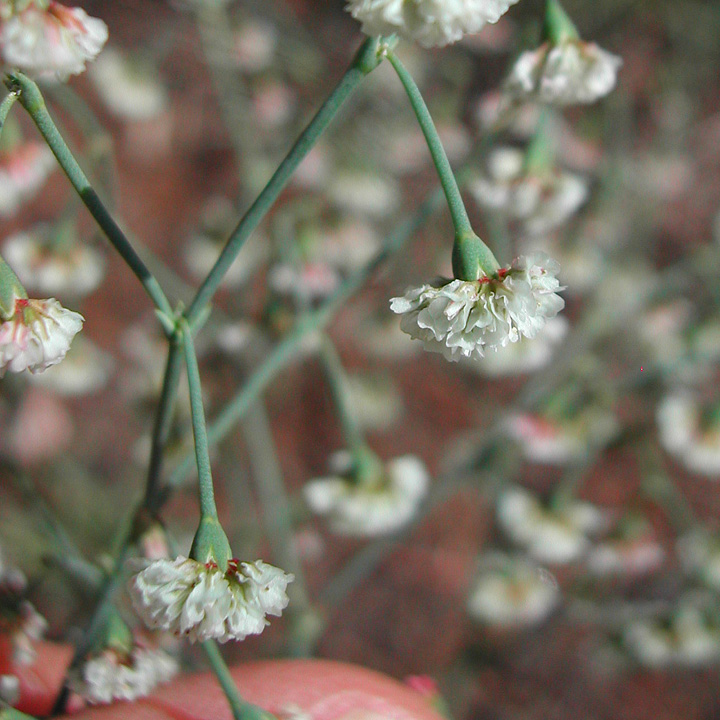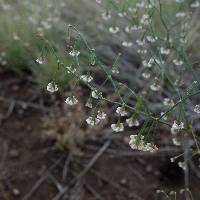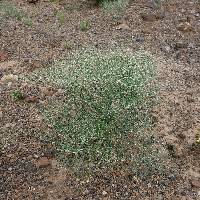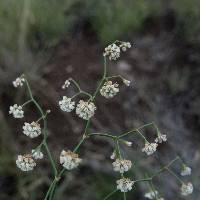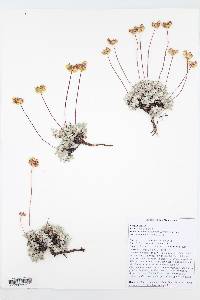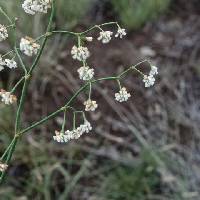|
|
|
|
Family: Polygonaceae
nodding buckwheat, more...nodding buckwheat
[Eriogonum cernuum subsp. tenue (Torr. & A.Gray) S.Stokes, moreEriogonum cernuum subsp. viminale S.Stokes, Eriogonum cernuum var. tenue Torr. & A.Gray, Eriogonum cernuum var. viminale (S.Stokes) Reveal] |
Herbs, spreading to erect, annual, 0.5-6 dm, glabrous, grayish, greenish or reddish. Stems: caudex absent; aerial flowering stems erect, solid, not fistulose, 0.3-2 dm, glabrous. Leaves basal or sheathing up stems 2-10 cm; petiole 1-4 cm, tomentose; blade round-ovate to orbiculate, (0.5-)1-2(-2.5) × (0.5-)1-2(-2.5) cm, white- to grayish-tomentose abaxially, tomentose to floccose or glabrate and grayish or greenish adaxially, margins plane. Inflorescences cymose, open to diffuse, 5-50 × 5-40 cm; branches glabrous; bracts 3, scalelike, 1-2 × 1-2.5 mm. Peduncles spreading to ascending or deflexed to cernuous, infrequently absent, straight or curved, slender, 0.1-2.5 cm, glabrous. Involucres turbinate, (1-)1.5-2 × 1-1.5 mm, glabrous; teeth 5, erect, 0.4-0.7 mm. Flowers 1-2 mm, glabrous; perianth white to pinkish, becoming rose to red; tepals dimorphic, those of outer whorl pandurate, those of inner whorl obovate; stamens mostly exserted, 1-2 mm; filaments pilose proximally. Achenes light brown to brown, 3-gonous, 1.5-2 mm, glabrous. Flowering Apr-Oct. Sandy to gravelly or clayey flats and slopes, mixed grassland, saltbush, sagebrush, and mountain mahogany communities, oak, pinyon-juniper, and conifer woodlands; 600-3100(-3300) m; Alta., Sask.; Ariz., Calif., Colo., Idaho, Mont., Nebr., Nev., N.Mex., Oreg., S.Dak., Utah, Wash., Wyo. Eriogonum cernuum is widely distributed, being infrequent to common or even abundant and weedy. It is common throughout most of its range in southeastern Oregon, eastern California, southern Idaho, Nevada, Utah, northern Arizona, and New Mexico. The species is rare in southeastern Washington (Franklin County). It is less common and more widely scattered in Colorado, Wyoming, and Montana, and on the northern Great Plains in southern Alberta and Saskatchewan, western South Dakota, and western Nebraska. The northern Great Basin phase, with sessile involucres, has been called var. viminale, but this difference now appears to be ecologic rather than genetic. Springer et al. 2008, FNA 2005 Duration: Annual Nativity: Native Lifeform: Forb/Herb General: Annual herb, 5-60 cm tall, from a slender taproot; stems spreading to erect, diffusely branched at or above the base, glabrous. Leaves: Clustered in a basal rosette, on tomentose petioles 1-4 cm long;occasionally also located on the lower stem, with petioles sheathing the stems; blades round-ovate to orbicular, 5-25 mm long and about as wide, with entire margins, the upper surface grayish and tomentose to greenish and nearly glabrous, and the lower surface white- to gray-tomentose. Flowers: White to pinkish, arranged in clusters of a few flowers held together by a cup-shaped structure called an involucre; involucres arranged in cymose inflorescences up to 40 cm wide and up to 50 cm high, with each involucre on a glabrous stalk (peduncle) 1-2 cm long, which can be ascending or pendulous; each individual flower is 1-2 mm high, with 6 ruffly petal-like tepals, these white to pinkish and becoming more red-tinted with maturity. Fruits: Achenes 3-angled, 1-2 mm long, light brown, glabrous. Ecology: Found on sandy to gravelly or clayey flats and slopes, in grassland and sagebrush communities, pinyon-juniper woodlands, and ponderosa pine and mixed conifer forests; from 2,000-10,000 ft (610-3048 m); flowers June-October. Distribution: Western N. Amer, from WA, Alberta, Saskatchewan, and SD, south to CA, AZ, and NM. Notes: A common annual buckwheat with slender stems and often-dangling clusters of delicate white to pink flowers. Leaves are round and clustered at or near the base of the plant, on stalks (petioles) up to 4 cm long. There are a number of quite similar annual buckwheats, so it is wise to make a collection. Eriogonum polycladon is one of the more common similar species. It is distinguished by its stems being erect, typically unbranched below the inflorescence, and densely white-tomentose (E. cernuum has glabrous stems); leaves which are whitish to grayish on both surfaces (E. cernuum leaves are white- or gray-hairy mostly on the underside); and involucres which are sessile or nearly so, and appressed to the inflorescence branches. Ethnobotany: Seeds were gathered by the Navajo (Diné) people, pounded into a meal, and eaten dry or made into a porridge. Also used to treat rashes, kidney disease, and ant bites. Etymology: Eriogonum comes from the Greek erion, wool, and gony, knee, alluding to the hairy nodes of the first species described, Eriogonum tomentosum; cernuum means face-down or bowing forward, referring to the stalks holding the flower clusters (peduncles) which are often downward-pointing in this species. Synonyms: None Editor: AHazelton 2017 |


